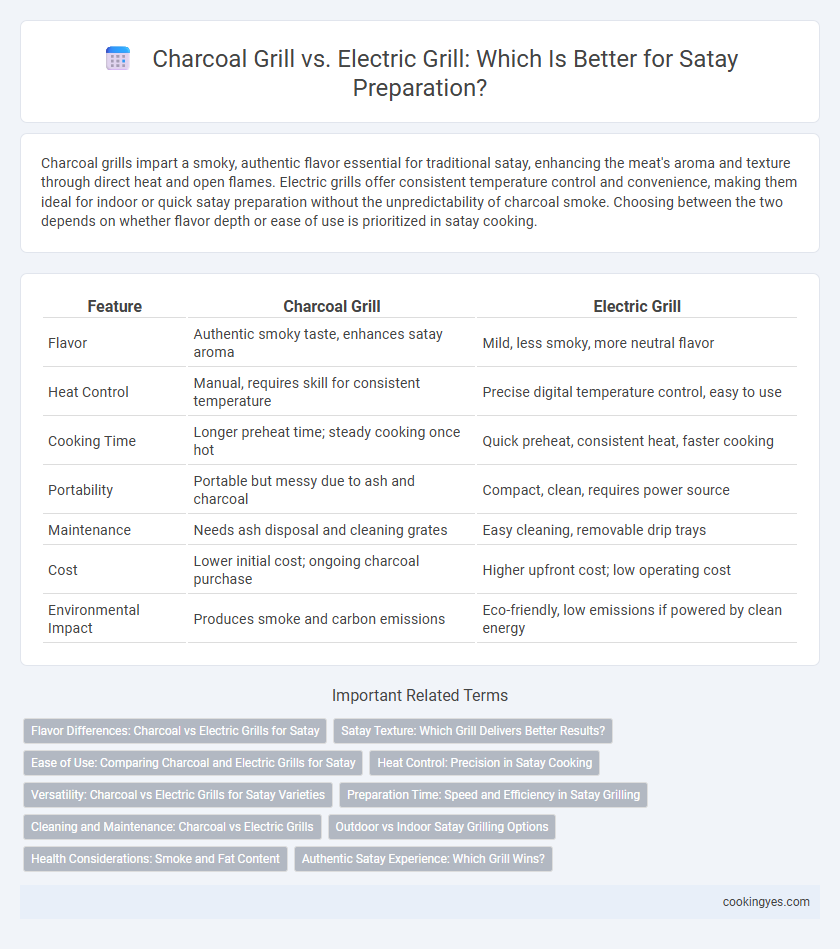Charcoal grills impart a smoky, authentic flavor essential for traditional satay, enhancing the meat's aroma and texture through direct heat and open flames. Electric grills offer consistent temperature control and convenience, making them ideal for indoor or quick satay preparation without the unpredictability of charcoal smoke. Choosing between the two depends on whether flavor depth or ease of use is prioritized in satay cooking.
Table of Comparison
| Feature | Charcoal Grill | Electric Grill |
|---|---|---|
| Flavor | Authentic smoky taste, enhances satay aroma | Mild, less smoky, more neutral flavor |
| Heat Control | Manual, requires skill for consistent temperature | Precise digital temperature control, easy to use |
| Cooking Time | Longer preheat time; steady cooking once hot | Quick preheat, consistent heat, faster cooking |
| Portability | Portable but messy due to ash and charcoal | Compact, clean, requires power source |
| Maintenance | Needs ash disposal and cleaning grates | Easy cleaning, removable drip trays |
| Cost | Lower initial cost; ongoing charcoal purchase | Higher upfront cost; low operating cost |
| Environmental Impact | Produces smoke and carbon emissions | Eco-friendly, low emissions if powered by clean energy |
Flavor Differences: Charcoal vs Electric Grills for Satay
Charcoal grills impart a rich, smoky aroma and complex flavor to satay by infusing the meat with natural wood smoke and high heat searing, enhancing its authentic taste. Electric grills provide a cleaner, more consistent cooking environment but lack the depth of smoky flavor typical of traditional satay preparation. For purists seeking an authentic experience, charcoal grilling remains the preferred method to achieve the signature char and caramelization that define classic satay flavors.
Satay Texture: Which Grill Delivers Better Results?
Charcoal grills produce a distinct smoky flavor and a crispy exterior on satay, enhancing the texture with slight charring and juiciness due to high, uneven heat. Electric grills offer consistent temperature control, which results in evenly cooked satay but may lack the authentic smoky aroma and subtle caramelization that define traditional satay texture. For optimal satay texture, charcoal grilling remains the preferred method among enthusiasts seeking that perfect balance of char and tenderness.
Ease of Use: Comparing Charcoal and Electric Grills for Satay
Charcoal grills provide traditional smoky flavor essential for authentic satay but require time-consuming ignition and frequent temperature adjustments, making them less convenient for beginners. Electric grills offer precise temperature control and quick startup, streamlining the cooking process with minimal monitoring, ideal for home chefs seeking ease of use. While charcoal enhances taste complexity, electric grills simplify preparation and cleanup, making them practical for everyday satay grilling.
Heat Control: Precision in Satay Cooking
Charcoal grills provide intense, uneven heat that can enhance the smoky flavor of satay but require skillful attention to manage temperature fluctuations. Electric grills offer precise heat control with adjustable settings, ensuring consistent cooking and reducing the risk of overcooking the delicate satay skewers. Maintaining optimal heat is crucial for achieving the perfect balance of tenderness and caramelization in satay preparation.
Versatility: Charcoal vs Electric Grills for Satay Varieties
Charcoal grills provide superior flavor depth and smoky aroma, enhancing the authentic taste of traditional satay varieties, while electric grills offer consistent temperature control for precise cooking and versatility in preparing various satay styles. Charcoal grills excel in grilling multiple skewers simultaneously, ideal for diverse satay assortments like chicken, beef, and lamb, whereas electric grills adapt well to indoor settings and quick adjustments for delicate meats and vegetables. Both grill types cater to different culinary needs, with charcoal favoring rich, smoky profiles and electric focusing on convenience and temperature precision for diverse satay recipes.
Preparation Time: Speed and Efficiency in Satay Grilling
Charcoal grills deliver authentic smoky flavors but require longer preheating times, often exceeding 20 minutes, which can slow down satay preparation. Electric grills heat up rapidly, typically within 5 minutes, allowing faster cooking cycles and increased efficiency in high-volume satay production. Choosing an electric grill optimizes preparation time without compromising consistent heat control essential for evenly grilled satay skewers.
Cleaning and Maintenance: Charcoal vs Electric Grills
Charcoal grills require intensive cleaning due to ash buildup and grease residue, demanding regular scraping and ash removal to maintain optimal performance. Electric grills offer easier maintenance with detachable, non-stick plates that simplify grease disposal and surface cleaning. Choosing electric grills reduces time spent on cleaning while charcoal grills provide authentic smoky flavor but require more diligent upkeep.
Outdoor vs Indoor Satay Grilling Options
Charcoal grills deliver authentic smoky flavors essential for traditional outdoor satay preparation, enhancing the meat's taste with natural smoke and high heat searing. Electric grills offer controlled temperature settings ideal for indoor satay cooking, providing convenience and reduced smoke emissions without compromising texture. Choosing between charcoal and electric grills depends on the setting--charcoal suits outdoor environments for authentic flavor, while electric grills enable indoor use with ease and consistent results.
Health Considerations: Smoke and Fat Content
Charcoal grills produce smoke containing polycyclic aromatic hydrocarbons (PAHs) and other carcinogens, increasing health risks compared to electric grills that emit minimal harmful compounds. The intense heat of charcoal grilling causes fat to drip and create smoke, which can deposit toxins on satay, whereas electric grills reduce flare-ups and fat exposure by consistent temperature control. Choosing electric grills improves health outcomes by minimizing exposure to smoke pollutants and enabling lower fat retention in satay preparation.
Authentic Satay Experience: Which Grill Wins?
Charcoal grills impart a distinct smoky flavor essential for authentic satay, enhancing the meat's caramelization and aroma through direct heat and wood smoke. Electric grills offer convenience and temperature control but often lack the signature char and smoky depth that define traditional satay. For true satay enthusiasts seeking an authentic culinary experience, charcoal grilling remains the preferred method.
Charcoal grill vs Electric grill for satay preparation Infographic

 cookingyes.com
cookingyes.com